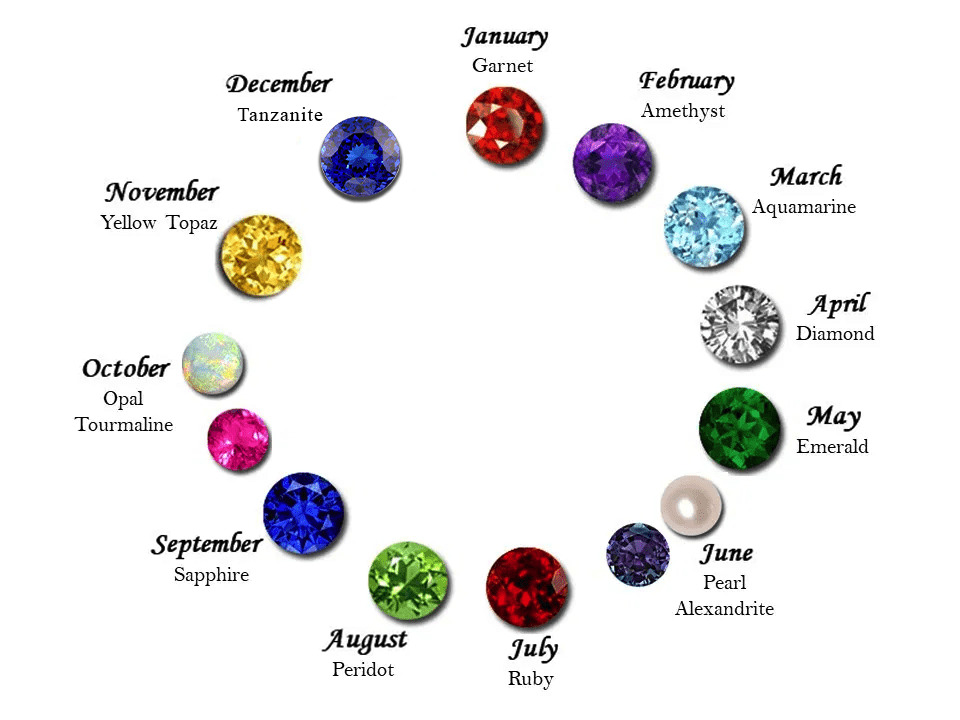Traditional Birthstone Chart Through the Ages
Since ancient times, certain precious stones have been associated with each month of the year. These traditional birthstones hold symbolic meaning and were thought to possess magical powers.
The modern birthstone chart that we use today has its origins in biblical times, though some alterations have been made over the centuries. Let’s go through a brief history of the traditional birthstone chart and the significance behind each stone.

Ancient Beginnings of Birthstones
References to birthstones date all the way back to the Bible’s Book of Exodus. Aaron, high priest of the Israelites, wore a breastplate adorned with 12 different gems representing the 12 tribes.
Some scholars believe the choice of stones also corresponded with the zodiac signs for each month. This early connection between birth months and special gems laid the foundation for birthstones.
Development of the Modern Birthstone Chart
In 1912, the American National Association of Jewelers released a standardized list of modern birthstones. This was meant to clear up conflicting birthstone lists used by various groups.
The Jewelers of America updated this official birthstone chart in 1952 by swapping the primary stone for March from bloodstone to aquamarine. They also replaced additional stones for each month.
The Meaning Behind Each Traditional Birthstone
Here is the traditional birthstone chart with the symbolic meaning of each stone:
- January – Garnet – Trust, friendship, and unity
- February – Amethyst – Sincerity, peace, and spiritual wisdom
- March – Aquamarine or Bloodstone – Courage, calmness, and protection
- April – Diamond – Strength, life, and eternity
- May – Emerald – Success, new beginnings, and foresight
- June – Pearl – Purity, faith, and loyalty
- July – Ruby – Passion, energy, and prosperity
- August – Peridot – Truth, power, and influence
- September – Sapphire – Insight, virtue, and peace
- October – Opal or Tourmaline – Hope, innocence, and spirituality
- November – Topaz or Citrine – Fidelity, joy, and imagination
- December – Turquoise – Wisdom, luck, and success
Alternative Birthstones By Zodiac Sign
Some people prefer choosing birthstones based on astrological signs rather than calendar months. Here are the zodiac stones:
- Aries (Mar 21-Apr 19) – Diamond
- Taurus (Apr 20-May 20) – Sapphire
- Gemini (May 21-Jun 20) – Agate
- Cancer (Jun 21-Jul 22) – Emerald
- Leo (Jul 23-Aug 22) – Onyx
- Virgo (Aug 23-Sep 22) – Carnelian
- Libra (Sep 23-Oct 22) – Peridot
- Scorpio (Oct 23-Nov 21) – Beryl
- Sagittarius (Nov 22-Dec 21) – Topaz
- Capricorn (Dec 22-Jan 19) – Ruby
- Aquarius (Jan 20-Feb 18) – Garnet
- Pisces (Feb 19-Mar 20) – Amethyst

The traditional birthstone chart has evolved over thousands of years while retaining its symbolic significance. People today can embrace both the classic and modern interpretations of birthstones when selecting meaningful jewelry. Whichever gems call out to you, these stones promise to inspire, protect, and delight.
FAQs about Birthstone Chart Traditional
What are the birthstones by month? January is garnet, February is amethyst, March is aquamarine, April is diamond, May is emerald, June is alexandrite, July is ruby, August is peridot, September is sapphire, October is tourmaline, November is topaz, December is blue topaz. Learn more about these popular gemstones.
Traditional birthstones have been used since approximately the 15th century. Modern birthstones are the “official” list, adopted in the early 20th century. Mystical birthstones are Tibetan in origin and date back over a thousand years. Ayurvedic birthstones are from ancient India circa 1500BC.
Traditional birthstones are the stones that were commonly associated with each month in the early 1900s. Modern birthstones were chosen by the Jewelers of America in the 1950s and updated periodically.
Emerald. As the birthstone for May, the emerald, a symbol of rebirth, is believed to grant the owner foresight, good fortune, and youth. Emerald, derived from the word “smaragdus,” means, quite literally, “green” in Greek.
